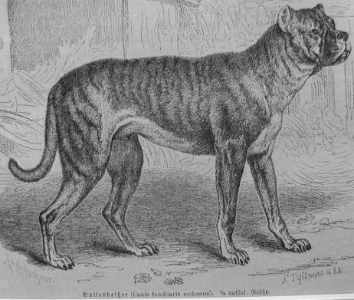- Bullenbeisser
Infobox Dogbreed

image_caption =
altname =
country =Germany
name = Bullenbeisser
extinct = trueThe Bullenbeisser (also known as the German Bulldog) was a breed of
dog known for its strength andagility . The breed was closely related to theBärenbeisser and some believe that the two breeds were the same (the names mean "bull-biter" and "bear-biter", respectively). The breed is extinct. [cite web |url=http://www.royalcanin.us/dogfood/maxiorigin.html |title=Canine Health Nutrition - MAXI Dog Origin (Boxer) |accessdate=2007-08-04 |author=Royal Canin ] [cite web |url=http://www.sarahsdogs.com/breeds/boxer/ |title=Sarah's Dogs: Breeds: Boxer |accessdate=2007-08-04 |author=SarahsDogs.com ]Background
Bullenbeissers' history can be traced back to 370 AD, the time the warriors called
Alans started migrating fromAsia Minor toEurope . They brought large fighting dogs with them (calledAlaunt s), which were probably descendant from huge dogs from the caucasus's and the steppes (animals very similar to the present breedsTibetan Mastiff ,Central Asian Shepherd Dog and Central Asian Ovcharka). After the conquest of theIberian Peninsula , by the late 5th century, the dogs were adopted in all countries of Europe. The main uses given to these dogs wereherding , guarding, and baiting.Central Europe was the zone in which the dogs were exposed to experience the greatest changes, though they evolved in each corner of the Old Continent. The main features of the direct ancestor of the Bullenbeisser are the loss of the long hair (since they abandoned the high mountains) and the acumulation of loose skin around the head and the muzzle. The appearance of these dogs quite similar to the modern
English Mastiff , perhaps with notable changes in colour. Around 800 a. d. there were different dogs in Brittania, Hispania, Italia, and Germania, all descendent from theAlaunt .Extinction
The Bullenbeisser became extinct by crossbreeding rather than by a decadence of the breed, as happened with the Old Time Bulldog, for instance. The size of the "Bull Baiters" varied from about 40 to 70 cm by 1850; the smaller lived from what today is
Netherlands andBelgium , and the bigger, inGermany . In the late 1870s, German breeders Roberth, Konig, and Hopner used the dog to create a new breed, today called Boxer. Some 30 Bullenbeissers were already crossed by the [http://www.bk-muenchen.de/cms/index.php Boxer Kennel Club of Germany] at 1900 in with Bulldogs brought from the British Isles. The blood composition was 50/50 at that time, however, the German owners started crossing their dogs with all kinds of Bulldogs and Boxers, which produced an undistinguishable breed after theWorld War II . One reason why such quantity of German blood was used to create the Boxer dog was the wish to eliminate the excessive white colour of the breed, and the necessity of producing thousands of dogs for one of the most popular breeds in the world.Present
The Boxer is descended about 70% from the Bullenbeisser. The
Great Dane is also a direct descendant of the Bullenbeisser. It is probable that Great Danes are about 40% descended from the even bigger Bullenbeissers. The [http://www.bulldoginformation.com/banter-bulldogge.html Banter Bulldog] is a very good recreation of the breed. However, the Bullenbeisser was in all its aspects, but for colour, almost identical to the presentDogo Argentino .ee also
*
Boxer (dog)
*Great Dane
*Bulldog
*Dogo Argentino References
External links
* [http://www.bulldoginformation.com/banter-bulldogge.html Banter Bulldog]
Wikimedia Foundation. 2010.
